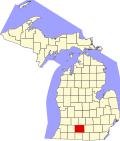Pine Creek Potawatomi Reservation | |
 Athens Indian Church | |
| Location | 1485 Mno-Bmadzewen Way, Fulton, Michigan |
|---|---|
| Coordinates | 42°06′15″N85°15′32″W / 42.10417°N 85.25889°W |
| Area | 120 acres (49 ha) |
| Built | 1845 |
| NRHP reference No. | 73000946 [1] |
| Added to NRHP | March 30, 1973 |
The Pine Creek Indian Reservation is the home of the Nottawaseppi Huron Band of Potawatomi (NHBP), a federally-recognized tribe of Potawatomi in the United States. The reservation headquarters is located at 1485 Mno-Bmadzewen Way, between Fulton, Michigan and Athens, Michigan. [2] The historic structures on the reservation were listed on the National Register of Historic Places in 1973. [1]
